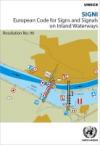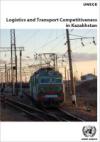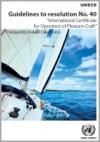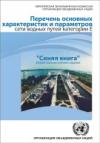Publications
Displaying Results 41 - 60 of 204
- English
The GHS addresses classification of chemicals by types of hazard and proposes harmonized hazard communication elements, including labels and safety data sheets. It aims at ensuring that information on physical hazards and toxicity from chemicals be available in order to enhance the protection of human health and the environment during the handling, transport and use of these chemicals.
The GHS
- English
The European Code for Signs and Signals on Inland Waterways (SIGNI), adopted by resolution No. 90 of the Working Party on Inland Water Transport on 5 October 2018, provides recommendations for the competent authorities for the installation and application of buoyage and marking on European inland waterways contained in the fifth revision of CEVNI (ECE/TRANS/SC
- English
Improving the competitiveness of Kazakhstan as a transport logistics centre at the crossroads of Europe and Asia could enable the country to unlock significant untapped benefits of growing cargo flows between the two continents. This study identifies the transport infrastructure and services available in Kazakhstan, reviews the country’s extensive recent and future transport investments,
- English
The European Agreement concerning the International Carriage of Dangerous Goods by Inland Waterways (ADN) done at Geneva on 26 May 2000 under the auspices of the United Nations Economic Commission for Europe (UNECE) and the Central Commission for Navigation on the Rhine (CCNR) has been in force since February 2008. The Agreement currently has eighteen Contracting Parties. The Regulations
- English
The International Certificate for Operators of Pleasure Craft (ICC) which is issued in accordance with resolution No. 40, is recognized by more than 25 United Nations Member States in the ECE region and beyond. The Guidelines to resolution No. 40 are based on the frequently asked questions of administrations and recreational boaters in order to facilitate an
- English
UNECE provides a common basis for harmonized traffic regulations on European waterways through the European Code for Inland Waterways (CEVNI), which contains the core uniform rules applicable to traffic on inland waterways. The fifth revised edition of CEVNI (CEVNI 5, available as PDF and
- English
Adopted on 30 September 1957 in Geneva under the auspices of the United Nations Economic Commission for Europe (UNECE), the ADR entered into force on 29 January 1968. This authoritative Agreement is intended to increase the safety of international transport of dangerous goods by road. Its Annexes A and B contain the technical requirements for road transport, i.e. the conditions under
- English
The present publication (download here) concerns intermodal transport, with a particular focus on the role of railways in intermodality and the importance of transport documents computerisation for intermodal transport. The publication is divided in three main parts: a first section discusses the intermodality and the role of
- English
ECE/TRANS/271, Sales No. E.17.VIII.2,ISBN 978-92-1-139160-2, Price: US$ 35, Languages: E, F, RThe Agreement on the International Carriage of Perishable Foodstuffs and on the Special Equipment to be Used for such Carriage (ATP) was done at Geneva on 1 September 1970 and entered into force on 21 November 1976. The objectives of
- English
The GHS addresses classification of chemicals by types of hazard and proposes harmonized hazard communication elements, including labels and safety data sheets. It aims at ensuring that information on physical hazards and toxicity from chemicals be available in order to enhance the protection of human health and the environment during the handling, transport and use of these chemicals.The GHS
- English
These recommendations have been developed in the light of technical progress, the advent of new substances and materials, the exigencies of modern transport systems and, above all, the requirement to ensure the safety of people, property and the environment. They are addressed to governments and international organisations concerned with the regulation of the transport of dangerous goods. The
- English
The objective of the Inventory of Main Standards and Parameters of the E Waterway Network (“Blue Book”) is to establish an inventory of existing and envisaged standards and parameters of E waterways and ports in Europe and to show, on an internationally comparable basis, the current inland navigation infrastructure parameters in Europe as compared to the minimum standards and parameters
- Pусский
Цель «Синей книги» - предоставить перечень существующих и планируемых характеристик и параметров водных путей и портов категории E в Европе и показать, на международно-сопоставимой основе, нынешние параметры инфраструктуры внутренних водных путей по сравнению с минимальными характеристиками и параметрами, предписанными в Европейском соглашении о важнейших внутренних водныхпутях международного
- Français
Le Livre bleu dresse un inventaire des normes et paramètres actuels et envisagés des voies navigables et ports E en Europe, régulièrement mis à jour par la Division des transports de la CEE-ONU, et présente, sur une base internationale comparable, les paramètres d'infrastructure actuels de la navigation intérieure en Europe par rapport à ceux des normes et paramètres minimaux prescrits dans l'
- English
The European Agreement concerning the International Carriage of Dangerous Goods by Inland Waterways (ADN) done at Geneva on 26 May 2000 under the auspices of the United Nations Economic Commission for Europe (UNECE) and the Central Commission for Navigation on the Rhine (CCNR) has been in force since February 2008. The Agreement currently has eighteen Contracting Parties.The Regulations
- English
Adopted on 30 September 1957 in Geneva under the auspices of the United Nations Economic Commission for Europe (UNECE), the ADR entered into force on 29 January 1968.This authoritative Agreement is intended to increase the safety of international transport of dangerous goods by road. Its Annexes A and B contain the technical requirements for road transport, i.e. the conditions under which
- English
ST/SG/AC.10/11/Rev.6Sales No. E.15.VIII.3ISBN 978-92-1-139155-8Price: US$ 125Languages: E, F, S (A, C, R forthcoming)How to order this publication?This publication is also available online for free (download).The Manual of Tests and Criteria contains criteria, test methods and procedures to be used for classification of
- English
ECE/TRANS/249, Sales No. E.15.VIII.2,ISBN 978-92-1-139153-3, Price: US$ 35, Languages: E, F, RThe Agreement on the International Carriage of Perishable Foodstuffs and on the Special Equipment to be Used for such Carriage (ATP) was done at Geneva on 1 September 1970 and entered into force on 21 November 1976. The objectives of
- English
The GHS addresses classification of chemicals by types of hazard and proposes harmonized hazard communication elements, including labels and safety data sheets. It aims at ensuring that information on physical hazards and toxicity from chemicals be available in order to enhance the protection of human health and the environment during the handling, transport and use of these chemicals.The GHS
- English
These recommendations have been developed in the light of technical progress, the advent of new substances and materials, the exigencies of modern transport systems and, above all, the requirement to ensure the safety of people, property and the environment. They are addressed to governments and international organisations concerned with the regulation of the transport of dangerous goods. The




















